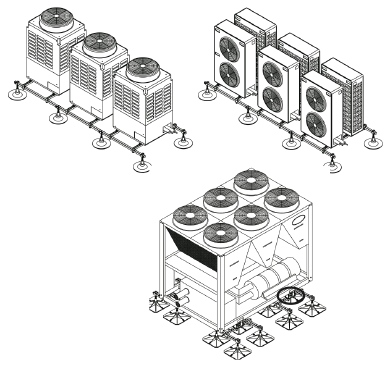Supporting roof-top plant
Non-invasive methods of supporting plant on flat roofs offer significant benefits over traditional concrete plinths. Laurence James of Pump House looks at how M&E contractors are changing their views on the best practice in supporting rooftop M&E building services.
If you have ever been up on a flat roof where there are old existing building services in-situ, it should be all too clear that the traditional manner of supporting these services is often less than ideal these days. The question now is whether these traditional methods of casting concrete plinths, building brick piers or manufacturing steelwork are becoming a thing of the past?
Traditional concrete plinths require shuttering works prior to concrete pouring, with additional waterproofing layers to be added following this. With brick piers, curing times and separate trades are also required. Steel plinths, which break through the waterproofing membrane and insulation down to the structural roof, can cause inherent risks themselves, such as potential cold-bridging issues, and may affect current Building Regulations Approved Document Part L energy-reduction targets.
It goes without saying that the time-frame and differing trades required to carry out such ‘old’ traditional detailing can have an adverse effect on the smooth running of building contracts. Potentially, there is the risk of delay should, for example, there be ingress of water through an area of extra waterproofing detailing carried out to these plinths.
The problems may be compounded in that traditional practices can cause headaches for the building owner or end user in respect of future upgrading of their flat-roof insulation. If replacement of the existing building services becomes necessary, in favour of smaller, more high-efficient equipment, the new items may not fit on the original plinth locations.
It is of little surprise then that we are seeing greater emphasis on utilising the non-invasive, independent and lightweight supporting products available in today’s market. These proprietary products are typically manufactured from mild-steel strut or box sections that are hot-dip galvanised to produce frameworks which support building services. The frameworks manage the imposed loading down through their polypropylene, plastic or rubber feet which can be square, rectangular or round. These feet stand on the finished waterproofing layer or on the insulation boards of an inverted roof design.
Since the introduction of independent support systems into the UK in the mid-1990s, contractors, specifiers and consultants alike are realising that these lightweight solutions negate many of the traditional problems and provide greater flexibility, whilst reducing unnecessary risk of delays to the project programme.
Why change?
One would suggest that the key to the rise of such products is their simplicity. These lightweight non-penetrating solutions can be manually positioned at the last minute, without being set within a pre-determined location dictated early on in the project works. They provide the installer with a fully flexible solution that, ultimately, is quick and simple to install with little, if any, training required.

As mentioned they negate the requirements for often awkward and time-consuming waterproofing detailing, avoiding cutting through the insulation layer and causing thermal deficiencies and potential interstitial condensation complications. These independent frameworks are robust enough to manage the heaviest building services such as large chillers and packaged plantrooms quite satisfactorily.
However these support solutions can come with some inherent risk themselves.
With a plethora of support systems now available to purchase through many different companies within the UK, the installer should not lose sight of key considerations associated with such systems. Because these solutions are lightweight and independent, they can be susceptible to wind loadings, particularly in exposed areas such as high-rise buildings or coastal environments. Therefore guidance and, if necessary, wind- loading data should be sort from the manufacturer prior to delivery.
Another factor is when heavy services such as packaged plantrooms, large chillers and air-handling units have concentrated loads that need to be managed to ensure the roofing insulation within the roof construction is not compromised and compressed. Again, creditable calculations relating to foot pressures, leg reactions and roof loadings ought to be a prerequisite, and a sound knowledge of modern-day flat roof designs and insulation types should be mandatory to ensure there are no inherent damaging effects to the roofing build-up following the installation of framework and plant on top.
Above all when the consumer chooses a supporting system they should ensure they are automatically receive technical support, long-term experience and professional advice from the product manufacturer. The manufacturer should automatically give consideration to all aspects associated with the support system —the roofing build-up beneath, the imposed roof loadings and foot pressures and wind-load management. Maintenance and service manuals for the support system should be available for inclusion in the O&M manuals for the end user/building owner.
With all factors considered and selection made these alternative solutions are clearly the way forward for future projects that require mechanical-and-electrical building services supported on flat roofs. Speed, simplicity and robustness are key, and it is of no surprise that we find ourselves working within an industry that chooses more often than not to use such systems over outdated traditional methods. After all time is money!
Laurence James is technical manager for Flexi Support Systems with Pump House.







